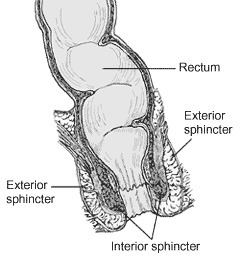Dorlands/Elsevier m_22/12550801 FMA 21930 | TA A04.5.04.012 | |
 | ||
Nerve Branch from the fourth sacral and contributions from the inferior hemorrhoidal branch of the pudendal nerve Latin Musculus sphincter ani externus | ||
The external anal sphincter (or sphincter ani externus ) is a flat plane of muscular fibers, elliptical in shape and intimately adherent to the skin surrounding the margin of the anus.
Contents
Anatomy
The external anal sphincter measures about 8 to 10 cm in length, from its anterior to its posterior extremity, and is about 2.5 cm opposite the anus, when defecation occurs the sphincter muscle retracts.
It consists of two strata, superficial and deep.
In a considerable proportion of cases the fibers decussate in front of the anus, and are continuous with the superficial transverse perineal muscle.
Posteriorly, they are not attached to the coccyx, but are continuous with those of the opposite side behind the anal canal.
The upper edge of the muscle is ill-defined, since fibers are given off from it to join the levator ani.
Actions
The action of this muscle is peculiar.
(1) It is, like other muscles, always in a state of tonic contraction, and having no antagonistic muscle it keeps the anal canal and orifice closed.
(2) It can be put into a condition of greater contraction under the influence of the will, so as more firmly to occlude the anal aperture, in expiratory efforts unconnected with defecation.
(3) Taking its fixed point at the coccyx, it helps to fix the central point of the perineum, so that the bulbospongiosus muscle may act from this fixed point.
Pathology
Anismus is a paradoxical contraction of the external anal sphincter, when the intent is relaxation, which can result in obstructed defecation and constipation. Abnormal function of this muscle is also seen in anorectal malformation and after certain surgeries, including coccygectomy.
